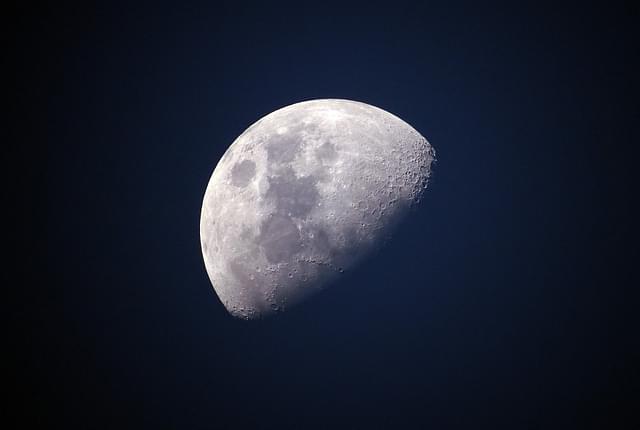Science
‘Blue Moon’ On 31 October: What It Is, What It Is Not, And Why It’s Intriguing
Karan Kamble
Oct 31, 2020, 06:16 PM | Updated 06:16 PM IST
Save & read from anywhere!
Bookmark stories for easy access on any device or the Swarajya app.

The expression “once in a blue moon” has been done to death in art, literature, and popular lexicon, but the real deal – the full blue moon – never gets old.
The blue moon is, after all, the full moon. What makes it special enough to have a different label is that it is the second full moon in a month. That doesn’t happen often, although it is not even as rare as the expression it has inspired suggests.
The same moon rises in the sky except that it doesn’t abide by our time standard, the 12-month calendar, that we have devised for going about our lives.
After a gap of two and a half years, which is roughly the interval between two such events, the blue moon will rise in the sky on 31 October. Of course, nothing changes for the moon itself, but we get another reason to celebrate our closest natural neighbour.
The first full moon of the month came in right at the start of it, 1 October, allowing a second full moon to sneak in right at the end.
Two full moons are separated by about 29 and a half days. This means that February never gets a blue moon. It also means that 31-day months have a better chance of hosting a blue moon. October happens to be 31 days long.
The night sky of 31 October will be even more spicy because not far from the moon, about two degrees apart in the sky, will be a planet with a reddish appearance. You would be right to guess it as Mars.
The red planet was already at its closest point to Earth on 6 October. Not till another 15 years have passed will it be this close again.
In the West, 31 October is doubly exciting this year as the rise of the “blue moon” is coinciding with Halloween, a holiday celebrated on 31 October every year in many countries.
Halloween is said to have its origins in the Celtic spiritual practice called Samhain. The ancient belief was that every year at this time, three days around 31 October, the barrier between the material and spirit worlds was breached and humans were likely to encounter folks from hidden worlds.
As Christianity grew around parts of the pagan world, leaders of the religion began to appropriate the Samhain celebration. It became a time to celebrate saints, for instance, during the reign of Pope Gregory in the ninth century and, soon enough, October 31 came to be marked as the All Hallows Eve or Halloween.
Over the centuries, the celebration picked up its popular practices such as wearing costumes and going trick-or-treating, although these activities too have come from ancient times.
Although the 31 October blue moon is the second full moon in the calendar month, the term “blue moon” has another, different, and older connotation. The third of four full moons in a single season also happens to be a blue moon. This is so because a typical season, comprising three months, is witness to three full moons in the sky. However, a fourth one comes along occasionally and the third of the four gets the “blue moon” label.
The last two blue moons as per the seasonal meaning, appeared on 21 May 2016 and 18 May 2019. The next one will be on 22 August 2021. So mark your calendars.
Sometimes – and this is rare – the blue moon of the month and the blue moon of the season both come about in the same year. For that to happen, there will have to be 13 full moons in both the calendar year and between two December solstices. This will happen next in 2048, according to an EarthSky report.
But whether it is the blue moon of the month or of the season, what the blue moon is not is the colour blue. For the moon to appear blue, there would need to be particles of a particular size – around one-millionth of a metre wide – in the atmosphere that scatter the light in such a way that the moon looks blue in colour.
In the past, volcanoes and wildfires have caused the moon to look blue for small periods of time.
The blue moon aside, what if, on the other extreme, there is no full moon in a calendar month? That can happen too, in February. According to Britannica, this happened four times in the twentieth century and is expected to maintain that rhythm in this century. This low frequency, ironically, is more in line with the connotation of “once in a blue moon” than its modern, traditional use.
According to the “The Sky This Week” video report by the Jawaharlal Nehru Planetarium in Bengaluru, the 31 October full moon will be near the Ashwini Nakshatra. Hence, the name given to this lunar month is Ashwayuja Masa.
This full moon will be near the apogee, the farthest point on the moon's orbit around Earth.
On a different note, October 2020 has been a special month for the moon. Recently, the discovery of water on the sunlit surface of the moon was announced. Additionally, it was learnt that water there may be more accessible than previously thought.
Read: Water On The Moon: New Findings Promise To Make Lunar Exploration A Tad Bit Easier And More Exciting
Save & read from anywhere!
Bookmark stories for easy access on any device or the Swarajya app.
Karan Kamble writes on science and technology. He occasionally wears the hat of a video anchor for Swarajya's online video programmes.
Support Swarajya's 50 Ground Reports Project & Sponsor A Story
Every general election Swarajya does a 50 ground reports project.
Aimed only at serious readers and those who appreciate the nuances of political undercurrents, the project provides a sense of India's electoral landscape. As you know, these reports are produced after considerable investment of travel, time and effort on the ground.
This time too we've kicked off the project in style and have covered over 30 constituencies already. If you're someone who appreciates such work and have enjoyed our coverage please consider sponsoring a ground report for just Rs 2999 to Rs 19,999 - it goes a long way in helping us produce more quality reportage.
You can also back this project by becoming a subscriber for as little as Rs 999 - so do click on this links and choose a plan that suits you and back us.
Click below to contribute.





